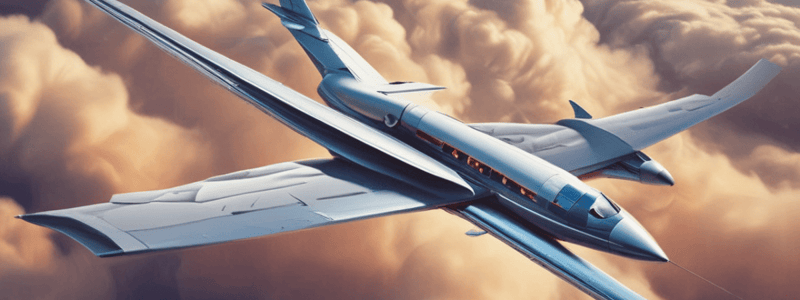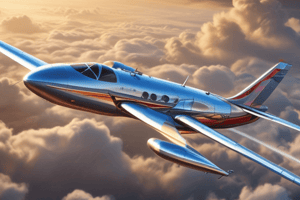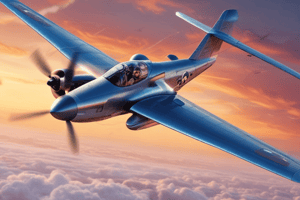Podcast
Questions and Answers
What is the primary goal of the pilot during an aircraft climb?
What is the primary goal of the pilot during an aircraft climb?
- To reduce engine power to minimize fuel consumption
- To increase altitude while maintaining a safe airspeed and rate of climb (correct)
- To maintain a minimum airspeed
- To execute a steep climb to minimize flight time
What is the primary reason why lift must be greater than weight during a climb?
What is the primary reason why lift must be greater than weight during a climb?
- To overcome the drag force
- To overcome the gravitational pull and allow the aircraft to ascend (correct)
- To provide the necessary acceleration for the climb
- To maintain a minimum airspeed
What is the primary benefit of trading altitude for airspeed during a descent?
What is the primary benefit of trading altitude for airspeed during a descent?
- To execute a steep descent to minimize flight time
- To increase engine power and airspeed
- To reduce fuel consumption (correct)
- To maintain a minimum airspeed
What is the primary factor that can affect the aerodynamics of descent?
What is the primary factor that can affect the aerodynamics of descent?
What is the primary cause of a stall during a climb or descent?
What is the primary cause of a stall during a climb or descent?
What is the primary response to a stall during a climb or descent?
What is the primary response to a stall during a climb or descent?
What is the primary goal of a pilot during a climb or descent?
What is the primary goal of a pilot during a climb or descent?
What is the primary relationship between thrust and drag during a climb?
What is the primary relationship between thrust and drag during a climb?
What is the primary consequence of a stall during a climb or descent?
What is the primary consequence of a stall during a climb or descent?
What is the primary importance of understanding the aerodynamics of climbs and descents?
What is the primary importance of understanding the aerodynamics of climbs and descents?
During an aircraft climb, the pilot aims to increase airspeed while maintaining a safe altitude and rate of climb.
During an aircraft climb, the pilot aims to increase airspeed while maintaining a safe altitude and rate of climb.
The forces involved in an aircraft climb include thrust, lift, and weight, but not drag.
The forces involved in an aircraft climb include thrust, lift, and weight, but not drag.
Pilots often use a climbing angle that minimizes climb rate while keeping an eye on engine performance and airspeed.
Pilots often use a climbing angle that minimizes climb rate while keeping an eye on engine performance and airspeed.
During a descent, the aircraft trades airspeed for altitude.
During a descent, the aircraft trades airspeed for altitude.
A stall occurs when the angle of attack decreases beyond a certain point, causing a sudden loss of lift.
A stall occurs when the angle of attack decreases beyond a certain point, causing a sudden loss of lift.
Proper pilot response to a stall includes raising the nose of the aircraft to reduce the angle of attack.
Proper pilot response to a stall includes raising the nose of the aircraft to reduce the angle of attack.
The aerodynamics of climbs and descents involve a delicate balance between lift, weight, and thrust.
The aerodynamics of climbs and descents involve a delicate balance between lift, weight, and thrust.
Air density has a negligible effect on the aerodynamics of descent.
Air density has a negligible effect on the aerodynamics of descent.
The primary goal of a pilot during a climb is to maintain a safe altitude.
The primary goal of a pilot during a climb is to maintain a safe altitude.
Understanding the aerodynamics of climbs and descents is only important for aircraft performance, not safety.
Understanding the aerodynamics of climbs and descents is only important for aircraft performance, not safety.
How does the pilot balance the forces involved during a climb to ensure a safe and efficient ascent?
How does the pilot balance the forces involved during a climb to ensure a safe and efficient ascent?
What are the consequences of failing to maintain a safe airspeed during a climb?
What are the consequences of failing to maintain a safe airspeed during a climb?
How does an aircraft's descent dynamics affect its fuel consumption?
How does an aircraft's descent dynamics affect its fuel consumption?
What role does air density play in the aerodynamics of descent?
What role does air density play in the aerodynamics of descent?
What is the pilot's primary concern when executing a climb or descent?
What is the pilot's primary concern when executing a climb or descent?
How does the pilot's response to a stall affect the aircraft's performance?
How does the pilot's response to a stall affect the aircraft's performance?
What is the relationship between the angle of attack and lift during a climb or descent?
What is the relationship between the angle of attack and lift during a climb or descent?
How does the pilot's management of the descent rate and airspeed affect the smoothness of the transition to approach and landing?
How does the pilot's management of the descent rate and airspeed affect the smoothness of the transition to approach and landing?
What is the significance of flap settings and speed brakes in the aerodynamics of descent?
What is the significance of flap settings and speed brakes in the aerodynamics of descent?
How does understanding the aerodynamics of climbs and descents contribute to safe aircraft operation?
How does understanding the aerodynamics of climbs and descents contribute to safe aircraft operation?
Flashcards are hidden until you start studying
Study Notes
Climb Dynamics
- During a climb, an aircraft's thrust must overcome drag and provide additional power to climb against gravity.
- The rate at which the aircraft ascends is the climb rate, critical for navigating terrain and optimizing flight path.
- The angle of climb is the angle at which the aircraft climbs, and it's affected by the aircraft's attitude.
- Pilots strive for an airspeed that allows the aircraft to climb efficiently, balancing all the forces involved.
- The phugoid cycle is a phenomenon where the aircraft experiences a long-term oscillation, climbing and descending, and pilots must manage it to ensure smooth flights.
Descent Dynamics
- Initiation of descent involves a shift in focus to the flight path angle, which helps regulate the rate of downward travel.
- Gravity becomes a key factor in descent, aiding in reducing the need for engine power.
- Flaps, spoilers, and airbrakes are used to enhance drag and regulate descent.
- The relationship between descent rate and forward airspeed is crucial, and pilots must manage it to ensure a safe and controlled approach.
- In emergency situations, pilots must find the best glide speed to maximize distance and manage descent.
Stall Scenarios and Pilot Response
- A stall occurs when the smooth airflow over the airplane's wings is disrupted, and the lift diminishes rapidly.
- A stall can happen if the wing reaches its critical angle of attack, and it's a situation every pilot must be prepared to face.
- Factors that can lead to a stall include abrupt maneuvers, flying too slow, or encountering strong winds or turbulence.
- Weight, balance, and speed can affect the risk of stall, and pilots must be aware of these factors to prevent stalls.
- Early recognition of stall warning signs is key, and pilots must take immediate corrective actions to prevent a fully-developed stall.
Prevention and Recovery from Stalls
- Proper recovery techniques include reducing the angle of attack by pushing the control column forward and increasing thrust to regain airspeed.
- Each aircraft may have specific procedures outlined in its operating handbook, which should be meticulously followed.
- Aircraft design plays a crucial role in stall characteristics, and understanding the specific aerodynamic properties and stall recovery techniques is vital.
- Best practices to prevent stalls during flight operations include maintaining appropriate airspeeds, making smooth and coordinated control inputs, and managing weight and balance parameters diligently.
Key Concepts
- The forces at play during climbs and descents include thrust, drag, lift, and weight.
- Understanding the aerodynamics of climbs and descents allows pilots to make informed decisions to maintain optimal performance and safety.
- The prevention of stalls is a critical aspect of both climbing and descending, and pilots must be aware of the factors that can lead to stalls and take corrective actions to prevent them.
Climb Dynamics
- During a climb, an aircraft's thrust must overcome drag and provide additional power to climb against gravity.
- The rate at which the aircraft ascends is the climb rate, critical for navigating terrain and optimizing flight path.
- The angle of climb is the angle at which the aircraft climbs, and it's affected by the aircraft's attitude.
- Pilots strive for an airspeed that allows the aircraft to climb efficiently, balancing all the forces involved.
- The phugoid cycle is a phenomenon where the aircraft experiences a long-term oscillation, climbing and descending, and pilots must manage it to ensure smooth flights.
Descent Dynamics
- Initiation of descent involves a shift in focus to the flight path angle, which helps regulate the rate of downward travel.
- Gravity becomes a key factor in descent, aiding in reducing the need for engine power.
- Flaps, spoilers, and airbrakes are used to enhance drag and regulate descent.
- The relationship between descent rate and forward airspeed is crucial, and pilots must manage it to ensure a safe and controlled approach.
- In emergency situations, pilots must find the best glide speed to maximize distance and manage descent.
Stall Scenarios and Pilot Response
- A stall occurs when the smooth airflow over the airplane's wings is disrupted, and the lift diminishes rapidly.
- A stall can happen if the wing reaches its critical angle of attack, and it's a situation every pilot must be prepared to face.
- Factors that can lead to a stall include abrupt maneuvers, flying too slow, or encountering strong winds or turbulence.
- Weight, balance, and speed can affect the risk of stall, and pilots must be aware of these factors to prevent stalls.
- Early recognition of stall warning signs is key, and pilots must take immediate corrective actions to prevent a fully-developed stall.
Prevention and Recovery from Stalls
- Proper recovery techniques include reducing the angle of attack by pushing the control column forward and increasing thrust to regain airspeed.
- Each aircraft may have specific procedures outlined in its operating handbook, which should be meticulously followed.
- Aircraft design plays a crucial role in stall characteristics, and understanding the specific aerodynamic properties and stall recovery techniques is vital.
- Best practices to prevent stalls during flight operations include maintaining appropriate airspeeds, making smooth and coordinated control inputs, and managing weight and balance parameters diligently.
Key Concepts
- The forces at play during climbs and descents include thrust, drag, lift, and weight.
- Understanding the aerodynamics of climbs and descents allows pilots to make informed decisions to maintain optimal performance and safety.
- The prevention of stalls is a critical aspect of both climbing and descending, and pilots must be aware of the factors that can lead to stalls and take corrective actions to prevent them.
Climb Dynamics
- During a climb, an aircraft's thrust must overcome drag and provide additional power to climb against gravity.
- The rate at which the aircraft ascends is the climb rate, critical for navigating terrain and optimizing flight path.
- The angle of climb is the angle at which the aircraft climbs, and it's affected by the aircraft's attitude.
- Pilots strive for an airspeed that allows the aircraft to climb efficiently, balancing all the forces involved.
- The phugoid cycle is a phenomenon where the aircraft experiences a long-term oscillation, climbing and descending, and pilots must manage it to ensure smooth flights.
Descent Dynamics
- Initiation of descent involves a shift in focus to the flight path angle, which helps regulate the rate of downward travel.
- Gravity becomes a key factor in descent, aiding in reducing the need for engine power.
- Flaps, spoilers, and airbrakes are used to enhance drag and regulate descent.
- The relationship between descent rate and forward airspeed is crucial, and pilots must manage it to ensure a safe and controlled approach.
- In emergency situations, pilots must find the best glide speed to maximize distance and manage descent.
Stall Scenarios and Pilot Response
- A stall occurs when the smooth airflow over the airplane's wings is disrupted, and the lift diminishes rapidly.
- A stall can happen if the wing reaches its critical angle of attack, and it's a situation every pilot must be prepared to face.
- Factors that can lead to a stall include abrupt maneuvers, flying too slow, or encountering strong winds or turbulence.
- Weight, balance, and speed can affect the risk of stall, and pilots must be aware of these factors to prevent stalls.
- Early recognition of stall warning signs is key, and pilots must take immediate corrective actions to prevent a fully-developed stall.
Prevention and Recovery from Stalls
- Proper recovery techniques include reducing the angle of attack by pushing the control column forward and increasing thrust to regain airspeed.
- Each aircraft may have specific procedures outlined in its operating handbook, which should be meticulously followed.
- Aircraft design plays a crucial role in stall characteristics, and understanding the specific aerodynamic properties and stall recovery techniques is vital.
- Best practices to prevent stalls during flight operations include maintaining appropriate airspeeds, making smooth and coordinated control inputs, and managing weight and balance parameters diligently.
Key Concepts
- The forces at play during climbs and descents include thrust, drag, lift, and weight.
- Understanding the aerodynamics of climbs and descents allows pilots to make informed decisions to maintain optimal performance and safety.
- The prevention of stalls is a critical aspect of both climbing and descending, and pilots must be aware of the factors that can lead to stalls and take corrective actions to prevent them.
Studying That Suits You
Use AI to generate personalized quizzes and flashcards to suit your learning preferences.




